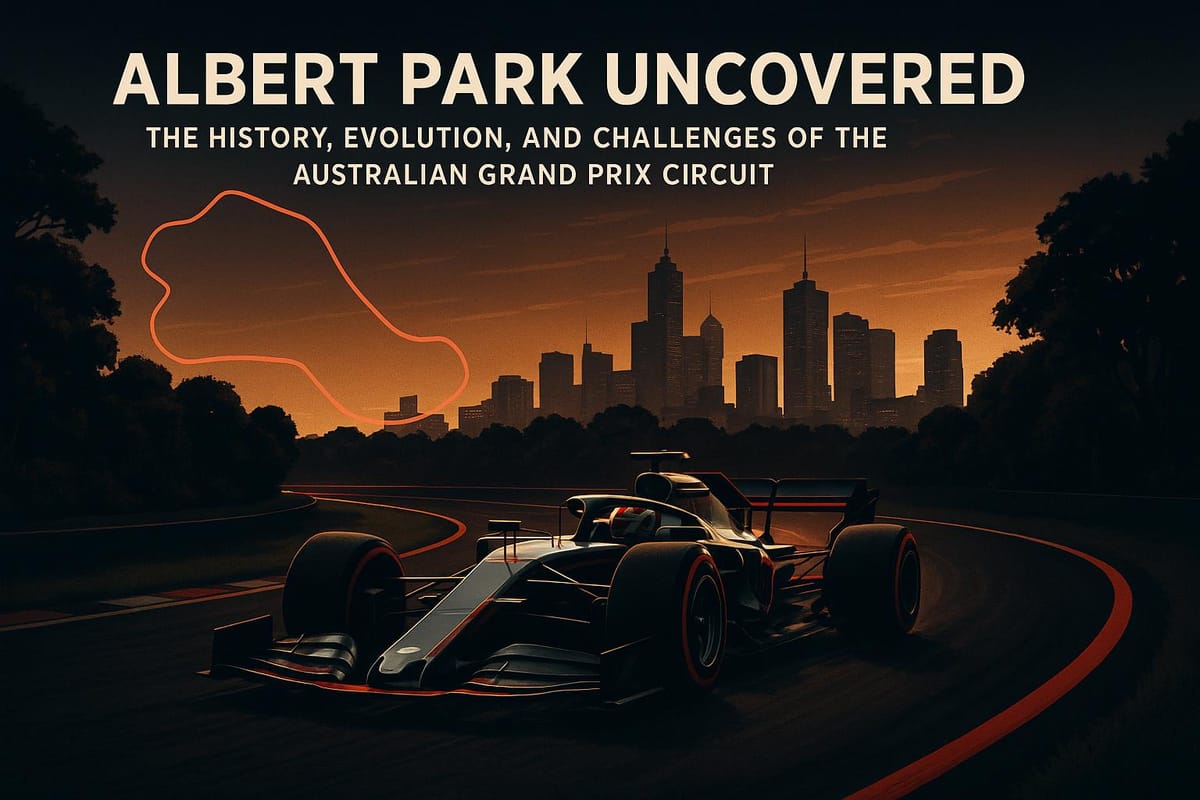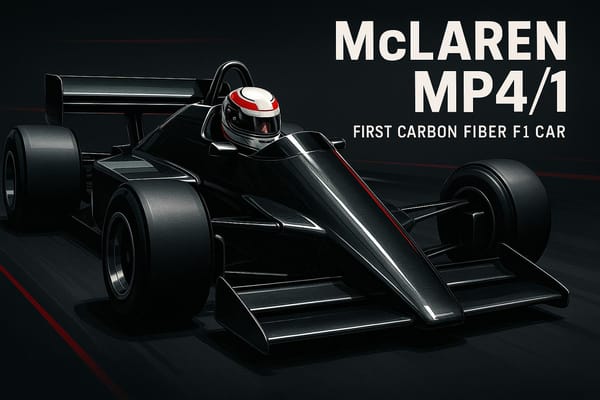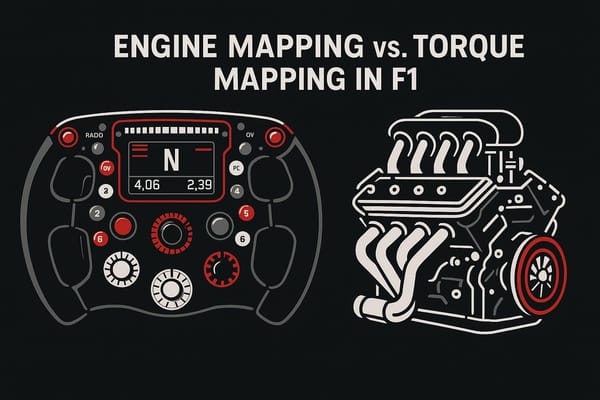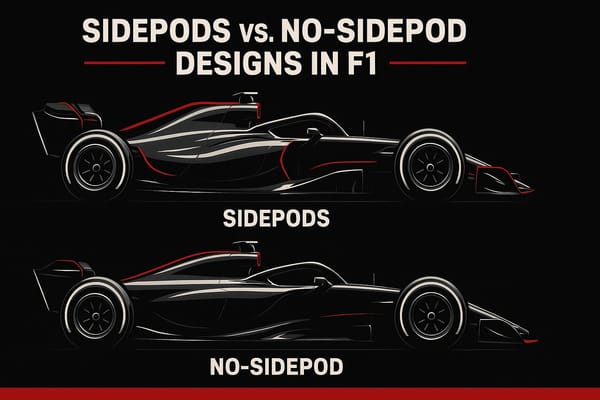Albert Park Uncovered: The History, Evolution, and Challenges of the Australian Grand Prix Circuit
Explore the rich history, evolution, and challenges of Albert Park, the iconic Australian Grand Prix circuit, and its impact on Formula One.

Albert Park is one of Formula One's most iconic circuits, combining the charm of a parkland setting with the intensity of a temporary street track. Since 1996, it has hosted the Australian Grand Prix, drawing massive crowds and evolving through significant updates to improve racing dynamics. Here’s what you need to know:
- Unique Status: The only venue to host the Australian Grand Prix in both championship and non-championship formats, with its history dating back to 1953.
- Track Evolution: Major upgrades between 2021–2023 included resurfacing, corner adjustments, and layout changes. These updates reduced lap times by 5 seconds and increased overtaking opportunities.
- Record-Breaking Attendance: In 2024, over 450,000 fans attended, showcasing its growing popularity.
- Economic Impact: In 2023, the event generated $268 million, with high hotel occupancy rates and thousands of interstate and international visitors.
Albert Park’s blend of history, modern updates, and strategic challenges ensures its place as a key stop on the Formula One calendar, secured until at least 2037. Keep reading to explore its fascinating transformation and racing intricacies.
Evolution Of Racing In Australia, Albert Park Circuit (1996-2024) | Formula 1
Origins and Development of Albert Park
Albert Park's journey to becoming a premier Formula One venue is a story of pivotal decisions and active community engagement. Its transformation reflects a blend of historical significance and modern innovation, solidifying its place on the Formula One calendar. Here's a look at its early racing days and the changes that shaped it into the circuit we know today.
Early Racing History: 1953-1995
Albert Park's motorsport legacy began in 1953, when the Light Car Club of Australia hosted the first Australian Grand Prix at the venue. Back then, the circuit measured 5.027 kilometers (3.124 miles) and featured nine turns. Between 1953 and 1958, the park hosted six racing events, attracting notable drivers of the era. Stirling Moss, for instance, set a lap record of 1:50.0 in 1958, driving a Cooper T45.
However, racing at Albert Park came to a halt when the Victorian Government banned events to maintain public access to the park. For nearly 40 years, the area primarily served as a recreational space, until discussions in the early 1990s reignited the idea of hosting Formula One races there.
F1 Circuit Development in 1996
The transformation of Albert Park into a Formula One circuit began in earnest in the early 1990s. In 1993, the Kennett Government struck a deal with Bernie Ecclestone to move the Australian Grand Prix from Adelaide to Melbourne. This announcement, made on December 17, 1993, marked a turning point for Australian motorsport.
The redevelopment process wasn't without its hurdles. The Australian Grand Prix Act, passed in October 1994, granted special permissions for the event but also sparked protests led by the "Save Albert Park" group. Construction involved significant changes to the area, including the consolidation of land, which impacted around 150 homes within a 200-meter radius of the circuit.
"The Grand Prix is an event like no other - bringing racing fans from interstate, overseas and locally and showcasing the state to millions of spectators right across the globe"
– Steve Dimopoulos, Minister for Tourism, Sport and Major Events
The economic benefits of the circuit have been substantial. Here’s a snapshot of its 2023 impact:
| Economic Impact Category | 2023 Figures |
|---|---|
| Total Economic Impact | $268 million |
| Direct Expenditure | $144 million |
| Interstate Visitors | 72,176 |
| International Visitors | 8,811 |
| Hotel Occupancy Rate | 90% |
Today, Albert Park stands as a centerpiece of the Formula One calendar, with the Australian Grand Prix secured until 2037. Its unique location, set within a park and framed by Melbourne's skyline, has cemented its iconic status.
"One thing that is really clear and consistent is they see Albert Park as an iconic venue. The fact it is in a park, on the doorstep of the city with the skyline as a backdrop, I haven't found anyone who's wanted to push a case to move it. In fact, if we were to move it, we would have to do so with F1's agreement."
– Travis Auld, Australian Grand Prix chief
Track Changes and Updates Since 1996
Original Track Design and Performance
When Albert Park made its debut in 1996, it featured a 5.303-km (3.295-mi) circuit with 16 turns. This design cleverly wove through the park's existing infrastructure, preserving its street circuit essence. However, the track surface, untouched since 1995, became a growing issue over the decades. Drivers frequently voiced concerns about overtaking being limited, as the circuit favored a single dominant racing line. To address these concerns, a major overhaul was set in motion in 2021 to elevate the track's performance.
2021–2023 Track Improvements
In early 2021, a comprehensive upgrade began, executed in three phases in collaboration with iEDM Motorsport. Here's a breakdown of the changes and their impact:
| Phase | Modifications | Impact |
|---|---|---|
| 1 | Pit lane widened by 2 meters | Allowed a potential increase in pit lane speed limit from 60 km/h to 80 km/h (37 mph to 50 mph) |
| 2 | Seven corners modified, two removed | Created more overtaking opportunities and quicker racing lines |
| 3 | Full circuit resurfacing | Improved grip and tire performance with the first new surface since 1995 |
Key corner adjustments were made to foster more dynamic racing:
- Turn 1: Widened by 2.5 m (8.2 ft) and reworked camber to ease congestion at the start.
- Turn 3: Extended by 4 m (13.1 ft) and given more positive camber to support multiple racing lines.
- Turn 6: Significantly widened by 7.5 m (24.6 ft), increasing corner speeds from 93 mph to 136 mph.
- Turns 9/10: The chicane was removed, creating a high-speed straight where cars now exceed 205 mph.
"These circuit modifications mean faster racing, with plenty of new opportunities for drivers to battle it out – come November, the Formula 1® Australian Grand Prix will be back and better than ever."
– Andrew Westacott, Australian Grand Prix Corporation CEO
These updates delivered measurable improvements:
- The circuit's length was slightly reduced to 5.279 km (3.28 mi), with the number of turns dropping from 16 to 14. This resulted in qualifying lap times being trimmed by approximately 5 seconds.
- Average speeds across the track increased by about 9.3 mph (15 km/h).
"These changes are in the direction of what we want. Better races, more battles – the changes are going to push us towards that."
– Daniel Ricciardo
In addition to the racing enhancements, the project added 4,000 m² (43,055 ft²) of parkland, demonstrating a commitment to balancing the needs of motorsport with preserving public space.
Racing Challenges at Albert Park
Albert Park presents a range of challenges for teams and drivers, from changing track grip to fine-tuning car setups and planning strategic pit stops. These factors highlight the ever-evolving nature of this iconic circuit.
Track Surface and Brake Management
As a temporary street circuit, Albert Park's surface conditions create unique hurdles. Early in the race weekend, the track offers very little grip until rubber is laid down, which directly affects both tire and brake performance. Drivers also contend with the track's bumpy nature, which adds another layer of difficulty.
"The bumps are part of the character of what Melbourne is so if you were to iron those out it would lose a lot. It does make it trickier for us but that's a part of it, you need that. I don't like these circuits which are super-flat and super-smooth, don't cause us troubles."
These uneven surfaces require teams to dial in precise car setups to handle the conditions effectively.
Car Setup Requirements
To tackle Albert Park's demands, teams rely on fine-tuned car setups. Here's a breakdown of key setup components and their purposes:
| Setup Component | Recommended Settings | Purpose |
|---|---|---|
| Aerodynamic Balance | 30-26 | Stability in fast corners |
| Transmission | 53% on-throttle, 52% off-throttle | Controlled power delivery |
| Suspension | 23-3 (front-rear) | Smooth handling through switchbacks |
| Ride Height | 34-37 mm | Clearance over kerbs |
| Brake Settings | 100% pressure, 55% bias | Maximum stopping power |
| Tire Pressures | 22.6 PSI front, 20.2 PSI rear | Balanced grip and performance |
These adjustments are critical for managing the circuit's mix of high-speed straights and tight corners.
Race Strategy and Pit Stops
The car setup doesn't just impact performance - it also shapes race strategies and pit stop timing. Historical data from the circuit reveals some key trends:
- Safety Car deployments occur in 67% of races.
- Virtual Safety Car (VSC) conditions appear in 50% of events.
- Red flags have been seen in one-third of races.
Pit stop timing is especially crucial under VSC conditions, as stops during these periods cost only 8 seconds compared to the usual 23 seconds.
"With the track in the current condition, and the evolution we had seen since Friday, the data collected shows the new compounds are generating less graining, and the one-stop race, starting on the medium tyre and moving to the hard, is the quickest on paper."
Safety car periods often provide teams with opportunities to gain an edge. For instance, in the 2018 Australian Grand Prix, Sebastian Vettel timed his pit stop during a Virtual Safety Car phase, minimizing time loss and securing a crucial victory. These moments underline the importance of adaptability and strategic thinking at Albert Park.
Albert Park vs Other F1 Circuits
Street Circuit Design Elements
Albert Park offers a unique blend of racetrack precision and street circuit charm, crafted annually from public roads and parking areas. Its design brings distinctive features to the table:
| Design Element | Impact on Racing | Comparison to Other Circuits |
|---|---|---|
| Surface Quality | Smoother than most street circuits, thanks to road sections rebuilt ahead of its F1 debut | Less bumpy compared to many traditional street circuits |
| Corner Profile | Features medium to high-speed corners | Delivers a more flowing layout than many other street circuits |
| Layout Type | Combines street circuit unpredictability with elements of permanent tracks | Balances public road challenges with sustained racing speeds |
These elements, along with recent upgrades, make Albert Park stand out among Formula 1 venues. The adjustments align with the technical changes discussed earlier, boosting the circuit's reputation for competitive racing.
"These circuit modifications mean faster racing, with plenty of new opportunities for drivers to battle it out – come November, the Formula 1 Australian Grand Prix will be back and better than ever."
– CEO Andrew Westacott
Passing Zones and DRS Impact
The updated design of Albert Park enhances close racing, setting it apart from other circuits. Spanning 3.28 miles, the track now features multiple DRS zones that encourage wheel-to-wheel battles. Average qualifying speeds have climbed to around 156 mph, while lap times have dropped by an impressive 5 seconds.
Turn 9/10 now sees approach speeds exceeding 205 mph, with drivers experiencing forces up to 5.4G. Changes to the pit lane have also expanded strategic options, creating more dynamic race scenarios.
"I've had positive feedback from the FIA and Formula One that technically speaking, a fourth DRS zone will be implemented. That means the cars will be going faster coming into turn 11, and if they are going faster, that means faster through that whole area and faster lap times."
– Andrew Westacott, Australian Grand Prix Corporation boss
Unlike many traditional street circuits that often limit drivers to single-file racing, Albert Park’s modernized layout encourages multiple racing lines, opening up more opportunities for overtaking.
Conclusion: Albert Park's Place in Modern F1
Since its debut in 1995, Albert Park has undergone significant updates, from major modifications to a complete resurfacing, resulting in faster lap times and higher speeds. These changes not only reflect technical progress but also reinforce the circuit's importance on the Formula One calendar .
Turn 6 stands out as a prime example of the track's modernization efforts, showcasing enhanced performance potential. By seamlessly combining its rich history with these updates, Albert Park remains a cornerstone of competitive racing in F1. The strong attendance numbers further highlight its growing appeal among fans.
"These changes are in the direction of what we want. Better races, more battles – the changes are going to push us towards that." - Daniel Ricciardo
Albert Park continues to balance tradition and progress, cementing its role as a vital part of modern Formula One.
FAQs
What impact have the recent changes to the Albert Park Circuit had on racing and driver strategies?
The changes to the Albert Park Circuit - such as widening corners, removing the Turn 9/10 chicane, and fully resurfacing the track - have had a noticeable impact on racing and strategy. These updates were aimed at promoting more overtaking opportunities and have led to faster lap times, with qualifying sessions now up to five seconds quicker.
With the new layout, overtaking has become less challenging, which might reduce the dependency on one-stop strategies. Still, the common approach often involves starting on medium tires and transitioning to hard tires. The resurfaced track and adjustments to the pit lane, including a possible increase in pit lane speed limits, have created additional options for teams when mapping out their race plans.
What challenges were faced during the transformation of Albert Park into a modern Formula One circuit, and how were they resolved?
The transformation of Albert Park into a top-tier Formula One circuit came with its fair share of obstacles. A key challenge was modernizing the outdated pit and paddock facilities, which had remained largely unchanged since their construction in the mid-1990s. To tackle this, a massive $350 million investment was approved to upgrade the Grand Prix precinct. The plan includes building a new pit complex, expanding hospitality spaces, and introducing infrastructure improvements that can be used year-round. Construction is scheduled to kick off after the 2026 Australian Grand Prix, with the project slated for completion by 2030.
Another pressing issue was the original track design, which restricted overtaking and forced drivers into a narrow, single-lane racing line. To address this, the circuit underwent a series of major updates. Key corners were widened, a chicane was removed, and the entire track was resurfaced. These upgrades not only improved overtaking opportunities but also increased the circuit's speed and made it a more challenging and exciting experience for drivers.
What makes the Albert Park Circuit stand out among other Formula One tracks?
The Albert Park Circuit in Melbourne, Australia, is a standout in the racing world thanks to its distinctive mix of features. This temporary street circuit winds around the scenic Albert Park Lake, offering a unique combination of smooth public roads and the tight, unforgiving layout of a classic street track, complete with daunting concrete barriers. The result? A fast, flowing course that pushes drivers to their limits and demands sharp strategic thinking from teams.
What makes Albert Park even more special is its breathtaking location. Set in a beautiful park with Melbourne's skyline as a dramatic backdrop, it provides an unforgettable experience for both fans and drivers. While the track's design doesn’t favor overtaking, with fewer long straights to create passing opportunities, this challenge injects an extra layer of strategy into every race, ensuring the action stays gripping from start to finish.
Related posts
- Imola’s Resurrection: From Tragedy to Triumph at the Emilia Romagna Grand Prix Circuit
- Monaco Grand Prix Circuit Guide: The Prestige, Precision, and Pressure of F1’s Crown Jewel
- Why Monaco Still Matters: The 2025 Grand Prix at the World’s Most Iconic Circuit
- Suzuka’s Legacy: How Japan’s Iconic Figure-8 Circuit Became a Driver Favourite




